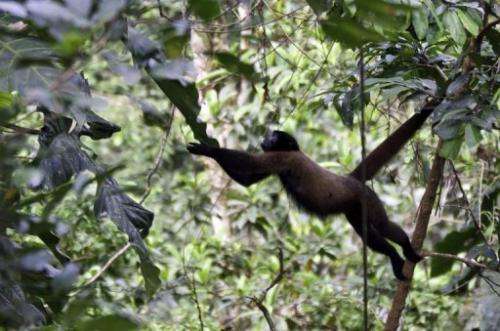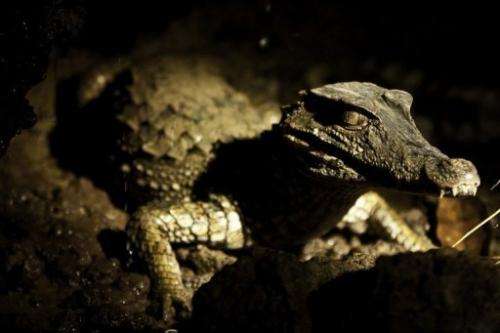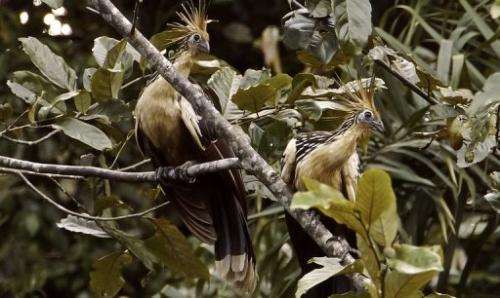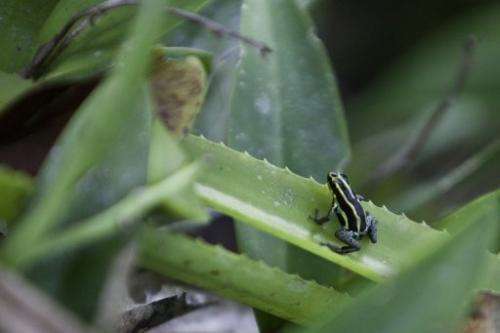A Brown woolly monkey leaps to a liana in Ecuador's Yasuni National Park. The park contains Ecuador's largest oil reserves, but its exploitation would imply impacts to pristine ecosystems, particularly watersheds.
The thumping whir of helicopters overhead sends a pack of terrified monkeys fleeing into the brush—one clear sign of the impact of oil development in this incredibly biodiverse part of Ecuador's Amazon.
This ecological paradise, a reserve called the Yasuni that is 9,820 square kilometers (about 3,800 square miles) large, is home to one of the highest concentrations of varied animal species in the world.
It also sits atop around 846 million barrels of crude oil—equivalent to a fifth of the total reserves of Ecuador, which relies heavily on oil exports for revenue.
In the name of environmental protection, President Rafael Correa has proposed a voluntary abstention from exploiting the oil in this reserve, in exchange for compensation from the international community to the tune of $3.6 billion, or about half the value of the estimated reserves in the protected area, by 2023.
Since 2011, however, the United Nations Development Program has raised only $200 million, a disappointment for Correa, who has not ruled out extracting the oil if he fails to raise the money.
In the meantime, the oil industry has continued to move into the area—including with helicopters.
"Two years ago, when I arrived, we never heard them. Starting five months ago, we hear them four times a week," said Sara Alvarez, a Spanish researcher, who monitors a grouping of 35 spider monkeys.
A Cuvier's dwarf caiman is seen on the Tiputini river in Ecuador's Yasuni National Park. The area, which served as a refuge for animals during the Ice Age, currently hosts a tenth of the world's species of plants, animals, and insects.
Alvarez said that tapping the oil deposits—and in particular, building the roads needed to get equipment and people in and the oil out—will destroy the natural habitat of the region's monkeys.
"If the monkeys have less space, they cannot access some fruit," said the expert.
Alvarez studies primate behavior in a research center about 50 kilometers (31 miles) from the oil fields at Tiputini, within the Yasuni reserve.
The director of the center, US researcher Kelly Swing, warned that the stress caused by oil development will have cascading effects on more than just the monkeys.
For one thing, the fruit-eating monkeys serve to disperse seeds—but fewer monkeys "would mean less seed dispersal and a loss of tree species," said Swing.
Two Hoatzin are perched on a tree in Ecuador's Yasuni National Park. The Yasuni reserve is a veritable Noah's Ark of species, thanks to its unique location at a convergence of the Amazon, the Andes mountains and the equator.
According to the research center, the Yasuni reserve is a veritable Noah's Ark of species, thanks to its unique location at a convergence of the Amazon, the Andes mountains and the equator.
The area, which served as a refuge for animals during the Ice Age, currently hosts a tenth of the world's species of plants, animals, and insects. On just one hectare, researchers found 100,000 species of insects.
Environmentalists say that developing the oil deposits will affect not only the plants and wildlife, but also natural water sources.
Mayer Rodriguez, 69, who has spent the last half century as a guide in the area, said the impact is already being felt, since developers started developing bloc 16 for oil in the mid-1980s.
He said that the Tiputini river banks were crowded with animals when he first came to the area 50 years ago.
A Poison dart frog sits on a leaf at Ecuador's Yasuni National Park. Yasuni sits atop around 846 million barrels of crude oil—equivalent to a fifth of the total reserves of Ecuador, which relies heavily on oil exports for revenue.
"There were jaguars, tapirs and monkeys everywhere. There are still many left, but nothing compared to what we had," he recalled.
Some scientists estimate that for each kilometer of new road built, 100 hectares (247 acres) of forest disappear. And a single tree can absorb one ton of carbon dioxide—the equivalent of the emissions emitted by 500 cars a year.
Oil industry detractors estimate that abandoning the Yasuni oil deposits would avert the emission of 407 million tonnes of carbon dioxide—about the amount emitted each year in Brazil or France.
But with oil one of the Ecuador's top exports and its main source of hard currency, leaving a precious resource untapped is a hard decision.
That said, the country also takes seriously its responsibility to preserve its incredible wealth of biodiversity—it is the country where US oil giant Chevron was ordered to pay a record $19 billion fine for pollution caused in the Amazon by its subsidiary between 1964 and 1990.
(c) 2012 AFP


























